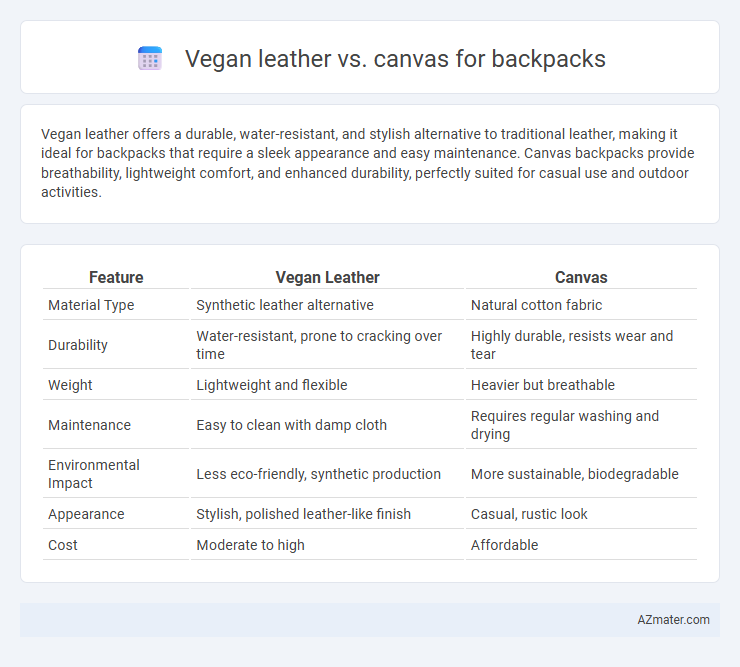Vegan leather offers a durable, water-resistant, and stylish alternative to traditional leather, making it ideal for backpacks that require a sleek appearance and easy maintenance. Canvas backpacks provide breathability, lightweight comfort, and enhanced durability, perfectly suited for casual use and outdoor activities.
Table of Comparison
| Feature | Vegan Leather | Canvas |
|---|---|---|
| Material Type | Synthetic leather alternative | Natural cotton fabric |
| Durability | Water-resistant, prone to cracking over time | Highly durable, resists wear and tear |
| Weight | Lightweight and flexible | Heavier but breathable |
| Maintenance | Easy to clean with damp cloth | Requires regular washing and drying |
| Environmental Impact | Less eco-friendly, synthetic production | More sustainable, biodegradable |
| Appearance | Stylish, polished leather-like finish | Casual, rustic look |
| Cost | Moderate to high | Affordable |
Introduction to Vegan Leather and Canvas
Vegan leather, a synthetic material designed to mimic genuine leather, offers a cruelty-free and water-resistant alternative often made from polyurethane or innovative plant-based sources like pineapple leaves or cork. Canvas, a woven fabric typically crafted from cotton or linen, provides exceptional durability, breathability, and a lightweight feel, making it a popular choice for backpacks. Both materials cater to eco-conscious consumers but differ in texture, maintenance, and environmental impact, influencing their suitability for various backpack styles and uses.
Material Composition and Sustainability
Vegan leather backpacks are made from synthetic materials such as polyurethane or natural alternatives like cork, providing a cruelty-free and water-resistant option with a sleek, leather-like finish. Canvas backpacks use woven cotton or other natural fibers, offering breathability, durability, and biodegradability while requiring significant water and pesticide input during cultivation. When assessing sustainability, canvas is often preferred for its natural origins and lower environmental impact in production, whereas vegan leather's eco-friendliness depends on the specific materials and manufacturing processes used.
Durability and Strength Comparison
Vegan leather offers a sleek appearance with moderate durability, resisting scratches and water effectively, making it suitable for daily urban use. Canvas, known for its ruggedness and high tensile strength, withstands heavy loads and rough handling, often outperforming vegan leather in long-term wear and tear. Both materials provide reliable options, but canvas generally excels in strength, while vegan leather offers better resistance to surface damage.
Water Resistance and Weather Performance
Vegan leather offers superior water resistance compared to canvas, effectively repelling moisture and preventing water absorption, making it ideal for wet conditions. Canvas, while breathable and durable, tends to absorb water, potentially leading to longer drying times and decreased weather performance without additional waterproof treatments. For backpacks exposed to frequent rain or humidity, vegan leather provides enhanced protection and maintains structural integrity better than untreated canvas materials.
Style and Aesthetic Appeal
Vegan leather backpacks offer a sleek, polished look with a smooth texture that mimics genuine leather, enhancing a sophisticated and modern style ideal for urban and professional settings. Canvas backpacks provide a rugged, casual aesthetic with a textured fabric that appeals to outdoor enthusiasts and those seeking a vintage or bohemian vibe. The choice between vegan leather and canvas ultimately depends on the desired fashion statement and the balance between elegance and casual comfort.
Comfort and Weight Factors
Vegan leather backpacks often feel heavier and less breathable compared to canvas, impacting overall comfort during extended wear. Canvas is typically lightweight and allows better air circulation, reducing perspiration and enhancing user comfort. Choosing between vegan leather and canvas depends on the balance between durability preference and the need for a breathable, lightweight backpack.
Eco-Friendliness and Ethical Considerations
Vegan leather offers a synthetic alternative to animal-derived leather, reducing animal cruelty and promoting cruelty-free fashion, while often relying on petroleum-based materials that can impact the environment. Canvas, typically made from natural fibers like cotton or hemp, provides biodegradability and renewable resource benefits but may involve intensive water and pesticide use during cultivation. Choosing sustainably sourced canvas or innovative plant-based vegan leather enhances eco-friendliness and aligns with ethical consumer values in backpack manufacturing.
Maintenance and Cleaning Requirements
Vegan leather backpacks require gentle cleaning with a damp cloth and mild soap to prevent damage, while avoiding harsh chemicals that can degrade the material. Canvas backpacks, made from durable cotton fibers, can often be spot cleaned or machine washed, but frequent washing may cause fading or shrinkage. Proper maintenance of vegan leather involves conditioning to keep the surface supple, whereas canvas benefits from water-repellent treatments to maintain durability and resistance to stains.
Price and Value for Money
Vegan leather backpacks generally have a higher price point due to their synthetic, eco-friendly materials and stylish appearance, offering durability and water resistance that justify the cost. Canvas backpacks are more affordable and provide excellent breathability and lightweight comfort, making them ideal for casual use but less resistant to weather and wear over time. For value for money, canvas is budget-friendly with classic appeal, while vegan leather offers a longer-lasting, premium look that suits those willing to invest more upfront.
Conclusion: Choosing the Right Material for Your Backpack
Vegan leather offers a stylish, water-resistant option ideal for urban use, while canvas provides superior breathability and durability suited for outdoor activities. Consider your lifestyle, environmental values, and maintenance preferences when selecting the material. Prioritizing eco-friendly production and long-term usability ensures the best choice for a sustainable, practical backpack.

Infographic: Vegan leather vs Canvas for Backpack
 azmater.com
azmater.com